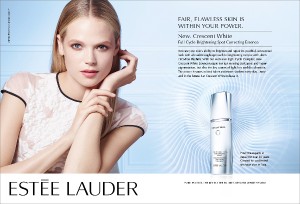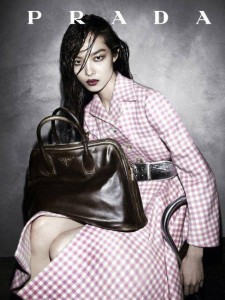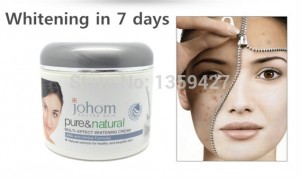Following the abandoning of Mao’s policies and the embracing of a consumer economy, professional wedding portraiture has become popular practice for Chinese couples. However, their portraits differ from those in the West because they are not candid shots taking during one’s wedding. Rather, they are elaborate photos taken in a studio on a day other than the wedding and in some cases long after the marriage has taken place. The goal of these portraits, as the following images will demonstrate, is not to capture romance between the couple. Instead, it is project a series of potentially false images about the couple: affluent, cosmopolitan, educated, western, or even that they are in love.
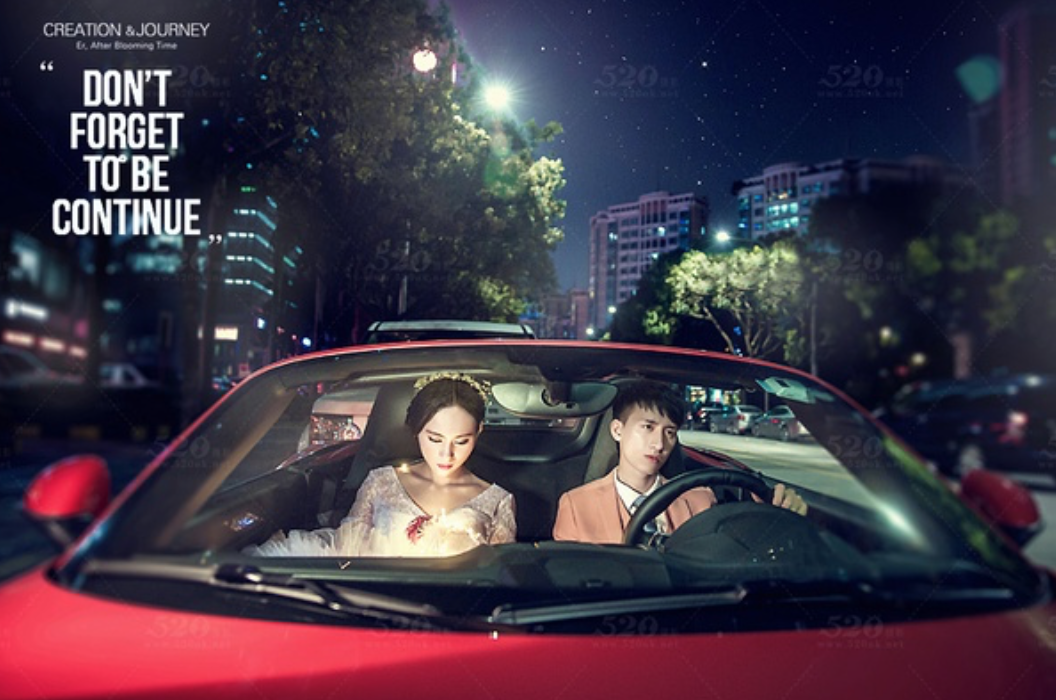
The image above features a woman in a wedding dress seated beside a man in a suit, presumably her husband, in an exotic red sports car set in a city. Above them is the phrase “Don’t forget to be continue” below “Creation&Journey.” Upon closer examination, it becomes evident that neither the bride nor the groom’s clothing fits them properly. The shoulder pads of his jacket extend far beyond his shoulders and terminate well above his arm, as evidenced by the bunching up of the material when it should lay naturally. Furthermore, how the jacket hangs on his frame indicates that it is meant for a man much larger than him. Likewise, her gown seems to be intended for a woman much larger than herself. The sleeves of the gown bunch up when they should lay flat when her arms are by her sides and the shoulder straps are elevated off her shoulders. An English speaker should also not that the phrase “don’t forget to be continue” does not make sense.
What these small details illuminate is that this is an intentionally fabricated image designed to convey a false level of affluence. A couple that can afford an exotic Italian sports car like the one in which they are depicted can also afford clothing that fits properly, especially for their wedding celebration. However, wedding portrait studios typically provide clothing for the portraits. The ill-fitting clothing coupled with the incoherent sentence above them suggests that they went to a cheap wedding studio. A sophisticated consumer spending lots of money on these portraits might have enough exposure to English to realize that sentence did not make sense. If not the couple depicted, then the other sophisticated clientele of the upscale portrait studio would have pointed it out to the photographer so that this mistake would not appear. This illustrates that a desire to project affluence transcends class and includes those for whom such levels of wealth are little more than a dream.
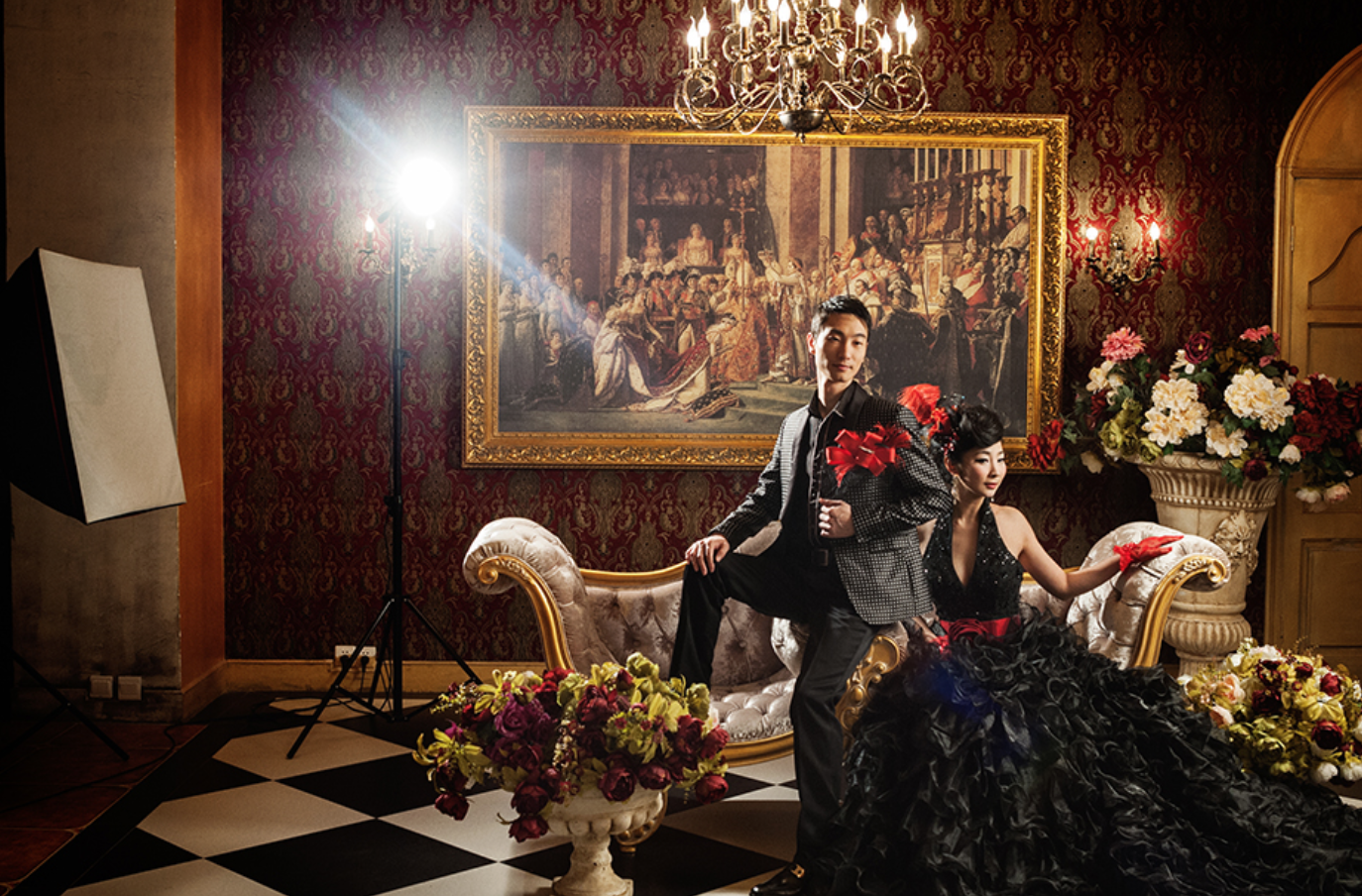
nice transition
Unlike the photo above, this is a photo of a wedding portrait’s being set up. We can see in the background the dirty concrete walls of the studio, as well as the studio lights behind the couple and beside them. Behind them is a western painting depicting a Christian scene. The couple is wearing Western clothing as well: a flowing black evening gown and an elegant suit coordinated to match her dress. They are seated on a French style couch and are flanked by European style vases, the furthest of which depicts the Greek gorgon. Above them is a chandelier.
As with the previous photo, this one shows the process by which an artificial sense of opulence is created. The bare concrete wall on the left side of the photo is dirty and covered with mold, hardly indicators of opulence, and it clashes quite vividly with the colorful scene around them. Both the floor and shape of the wall suggest that this is a contained “reality” whose truths do not extend more than a few feet. However, this couple might be more affluent than the previous couple as the studio’s attention to detail is far more acute than the previous studio. Not only does her dress perfectly match his suit, but they are also complemented by the floor itself and are balanced elegantly by the shadows cast by the studios lights; neither of their costumes glaringly clash with the scene around them as the man’s suit did above. Furthermore, both of their costumes appear to fit them properly, which also suggests that they are more affluent than the other pair. The incorporation of Western paintings and ancient Greek symbology in the form of the gorgon on the vase suggests that the couple sees Western history as a commodity that can be used to express wealth rather than just Western cars or clothing.
In conclusion, both of these photos illustrate a cross class desire to project false realities in Chinese wedding portraits. When juxtaposing the first and second image, attention to detail by the photographer in terms of how the clothing fits the subjects demonstrates that these photos appeal to poor and rich consumers alike. The second photograph illustrates the extent to which these photos are fabricated: a gorgeous, European-style background in a filthy, mold covered photo studio. Both photos through their use of European decor and the first’s use of English demonstrate a desire to commodify Western culture to project a false cosmopolitan nature.
introduce “Western decor and Chinese application in wedding portraits” as thesis statement at the beginning. In so doing, your analysis will be driven by potential explanation of why so.

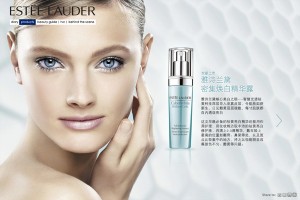 In the photo to the left, there is a fair skinned, light-haired, young, western female posing for an ad advertising makeup. It’s clear that this woman is a model and has very attractive facial features that draw consumers to immediately stare at her beauty. Sometimes this stare can become a gaze of envy. Her bright blue eyes draw the consumer in like a black hole. Her skin is soft and if you look close enough, her skin is shining a little. Her skin in contrast with the white backdrop shows that she truly has a pale skin tone. Once the consumer has taken in all of this model’s beauty, the eyes immediately look for what product made this woman look this way. The make-up container that is juxtaposed to her face is the center of the photo, sharing an equal amount of focus with the actual model. The containers label says “CyberWhite, Brilliant Cells”. Because the container says “CyberWhite” on it, the ad is selling the luxury of having paler, whiter skin, as opposed to tan, darker skin.
In the photo to the left, there is a fair skinned, light-haired, young, western female posing for an ad advertising makeup. It’s clear that this woman is a model and has very attractive facial features that draw consumers to immediately stare at her beauty. Sometimes this stare can become a gaze of envy. Her bright blue eyes draw the consumer in like a black hole. Her skin is soft and if you look close enough, her skin is shining a little. Her skin in contrast with the white backdrop shows that she truly has a pale skin tone. Once the consumer has taken in all of this model’s beauty, the eyes immediately look for what product made this woman look this way. The make-up container that is juxtaposed to her face is the center of the photo, sharing an equal amount of focus with the actual model. The containers label says “CyberWhite, Brilliant Cells”. Because the container says “CyberWhite” on it, the ad is selling the luxury of having paler, whiter skin, as opposed to tan, darker skin.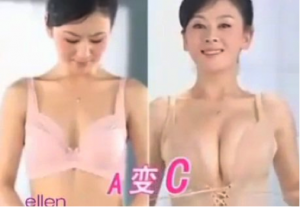 breast enhancement advertisement. The ad was shown on the Ellen DeGeneres talk show. In the advertisement, women put on the bra like device that is meant to be pulled in repeatedly. This action of pulling the breast together is said to bring other fat from other areas of the body to the breast region. On the Ellen show she mocks how implausible this process would be in effectively enlarging the breast. This begs the question,
breast enhancement advertisement. The ad was shown on the Ellen DeGeneres talk show. In the advertisement, women put on the bra like device that is meant to be pulled in repeatedly. This action of pulling the breast together is said to bring other fat from other areas of the body to the breast region. On the Ellen show she mocks how implausible this process would be in effectively enlarging the breast. This begs the question, 
